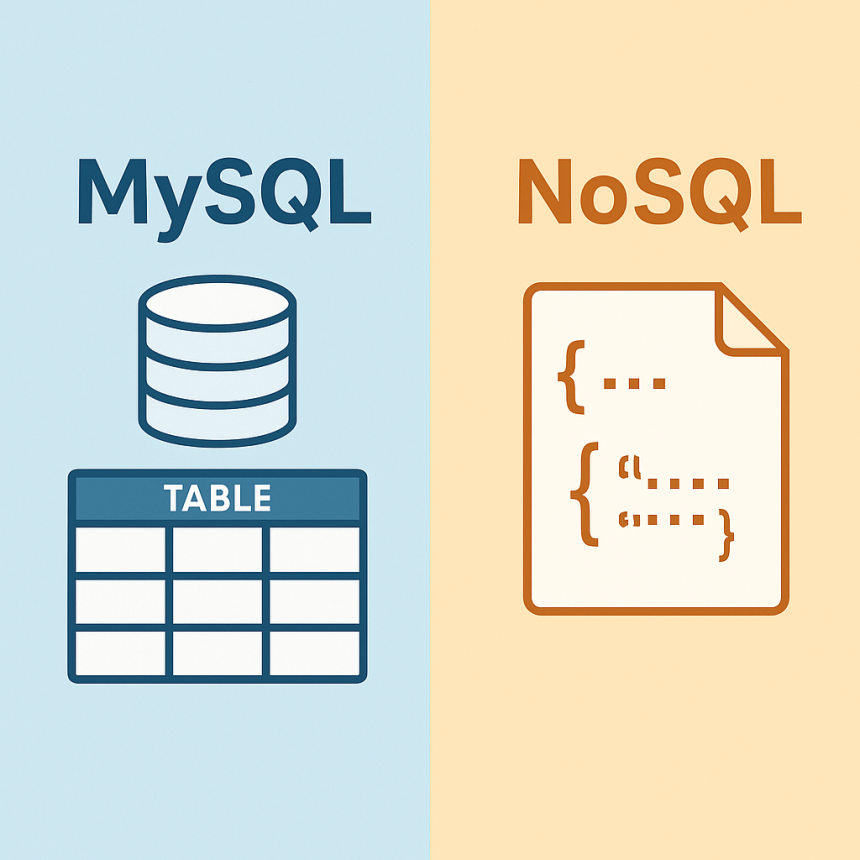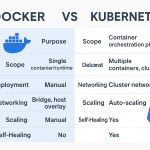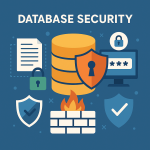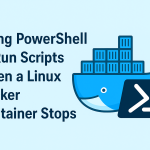MySQL vs NoSQL: Key Differences, Use Cases, and Examples
Databases form the foundation of nearly every modern application. Whether it’s managing user profiles, tracking inventory, handling social posts, or storing IoT data — efficient data storage and retrieval is key. The two most widely used types of databases are:
- Relational Databases (e.g., MySQL)
- Non-relational / NoSQL Databases (e.g., MongoDB, Redis, Cassandra)
Choosing the right type of database has a significant impact on how your system performs, scales, and evolves over time.
2. What is MySQL?
MySQL is a Relational Database Management System (RDBMS) developed by Oracle. It uses SQL (Structured Query Language) to store and manage data in tables, which are made up of rows and columns.
Key Features:
- Predefined, fixed schema
- Relationships via foreign keys
- ACID-compliant: ensures atomicity, consistency, isolation, durability
- Maintains data integrity
Example Table:
CREATE TABLE users (
id INT PRIMARY KEY AUTO_INCREMENT,
name VARCHAR(100),
email VARCHAR(100) UNIQUE,
created_at TIMESTAMP DEFAULT CURRENT_TIMESTAMP
);
3. What is NoSQL?
NoSQL is a broad category of database systems that don’t rely strictly on relational models. These databases are built for:
- High performance
- Easy horizontal scaling
- Flexible, schema-less data structures
Types of NoSQL Databases:
- Document-oriented (e.g., MongoDB)
- Key-value stores (e.g., Redis)
- Column-family (e.g., Cassandra)
- Graph-based (e.g., Neo4j)
4. MySQL vs. NoSQL: Core Differences
| Feature | MySQL | NoSQL |
|---|---|---|
| Data Structure | Tables | Documents, key-value, etc. |
| Schema | Fixed | Flexible |
| Query Language | SQL | JSON, XPath, CQL, etc. |
| Transactions | ACID | BASE (eventual consistency) |
| Scaling | Vertical | Horizontal |
| Relationships | Built-in JOINs | Managed in app logic |
| Best Use Cases | Structured data, OLTP | Big data, analytics, real-time |
5. MySQL: Architecture & Examples
MySQL organizes data in multiple related tables, with each having a defined schema that specifies column types and relationships.
Example: E-commerce Schema
Users Table:
CREATE TABLE users (
user_id INT AUTO_INCREMENT PRIMARY KEY,
username VARCHAR(100),
email VARCHAR(100)
);
Orders Table:
CREATE TABLE orders (
order_id INT AUTO_INCREMENT PRIMARY KEY,
user_id INT,
total_amount DECIMAL(10,2),
order_date DATE,
FOREIGN KEY (user_id) REFERENCES users(user_id)
);
Sample Query:
SELECT users.username, orders.total_amount
FROM users
JOIN orders ON users.user_id = orders.user_id;
This setup is ideal for apps where data is well-structured and interrelated.
6. NoSQL Types & Examples
a) Document Store – MongoDB
Stores data as JSON-like documents.
{
"_id": "user123",
"name": "Sunil Kumar",
"email": "[email protected]",
"orders": [
{ "id": "order001", "amount": 250 },
{ "id": "order002", "amount": 300 }
]
}
Query:
db.users.find({ "name": "Sunil Kumar" })
b) Key-Value Store – Redis
Focused on speed; values are accessed by keys.
SET user:1001 '{"name":"Anjali","email":"[email protected]"}'
GET user:1001
c) Column-Family – Cassandra
Optimized for high write throughput across distributed systems.
CREATE TABLE users_by_city (
city TEXT,
user_id UUID,
name TEXT,
PRIMARY KEY (city, user_id)
);
d) Graph DB – Neo4j
Great for capturing relationships like friends or followers.
CREATE (a:User {name: "Alice"})-[:FRIEND]->(b:User {name: "Bob"})
7. Performance & Scalability
| Category | MySQL | NoSQL |
|---|---|---|
| Reads | Fast with indexes | Very fast, especially key-value |
| Writes | Moderate | Typically faster |
| Joins | Built-in and efficient | Limited or manual |
| Scaling | Vertical | Horizontal (scale-out) |
| Sharding | Manual | Native in MongoDB, Cassandra |
| Consistency | Strong (ACID) | Eventual or configurable |
NoSQL often excels in handling heavy write loads and massive data volumes due to its distributed nature.
8. When to Use Which
✅ Choose MySQL If:
- Your data structure is consistent
- ACID compliance is essential (e.g., banking systems)
- You need complex queries with JOINs
- Your application isn’t extremely large-scale
✅ Choose NoSQL If:
- Your data is unstructured or evolving
- Scalability and speed are priorities
- You’re handling large volumes (e.g., logs, IoT)
- A flexible schema is beneficial
9. Real-World Example: E-Commerce
Using MySQL:
- Users: Table with defined name/email types
- Products: Strict schema for categories, pricing
- Orders: Linked via foreign keys
Benefits: Structured data, data integrity, solid reporting
Using MongoDB:
{
"_id": "user789",
"name": "Aarav",
"email": "[email protected]",
"orders": [
{ "order_id": "A101", "items": ["P1", "P3"], "amount": 320 }
]
}
Benefits: Flexible structure, no JOINs needed, scales easily
10. Summary: Pros & Cons
MySQL Pros:
- Well-established and documented
- Built-in relational support
- ACID-compliant
- Excellent for reporting
MySQL Cons:
- Less flexible schema
- Scaling is costly
- May slow down with high write loads
NoSQL Pros:
- Easily scalable
- Flexible data formats
- Great for large, distributed systems
- Real-time optimized
NoSQL Cons:
- Consistency isn’t always strong
- Relationships managed manually
- Complex queries can be harder
11. Final Thoughts
There’s no universal winner — it all depends on your needs. For reliability and structured operations, MySQL works best. If you’re chasing speed, scale, or evolving schemas, NoSQL may be the better fit.
🔍 Tip:
- For MVPs or fast-growing startups, MongoDB can offer flexibility.
- For secure, data-sensitive apps like CRMs or finance tools, MySQL offers robustness.
- Or, go hybrid — combine both using a polyglot persistence strategy.










